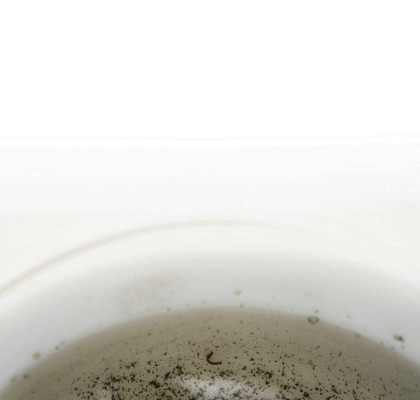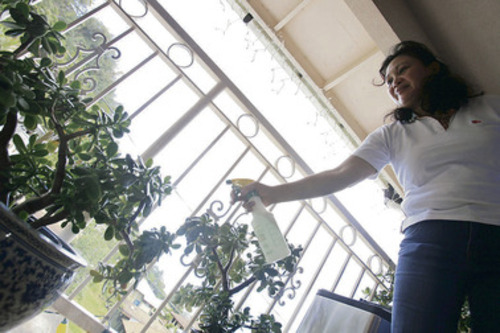Dengue fever fight comes home

Nelsa Sadaya lifted a potted plant on her lanai yesterday to find stagnant water, a prime breeding ground for mosquitoes.

PHOTOS BY JAMM AQUINO / JAQUINO@STARADVERTISER.COM A mosquito larva, the C-shaped organism in the middle of the photo, floated in a bucket of water yesterday in Kalihi Valley. Inset, Nelsa Sadaya sprayed a homemade mosquito repellent, which is a mixture of dishwashing detergent and water, over her plants on her lanai yesterday in Kalihi Valley.

Nelsa Sadaya sprayed a homemade mosquito repellent, which is a mixture of dishwashing detergent and water, over her plants on her lanai yesterday in Kalihi Valley.



Nelsa Sadaya used a simple mixture of tap water and dishwashing soap to spray dozens of potted plants surrounding her Kalihi Valley home yesterday to try to stop the spread of dengue fever.
Sadaya also learned yesterday that a similar solution of water and vegetable oil also helps kill mosquitoes — while sparing her plants.
"Mosquitoes everywhere," Sadaya said. "This is simple."
With the state’s mosquito-killing efforts nearly wiped out from budget cuts, state Rep. John Mizuno (D, Kalihi) and City Councilwoman Tulsi Gabbard Tamayo, whose district includes Kalihi Valley, encouraged Sadaya and her husband, Zaldy, to fill the gap in Hawaii’s mosquito eradication efforts themselves yesterday by pouring out standing water and by spraying plants with diluted vegetable oil or dishwashing soap.
"Everyone can take their own preventative measures," Gabbard Tamayo said. "Each and every one of us has to do our part. … This is not isolated to Kalihi Valley. This is a statewide issue."
The state Department of Health has confirmed four cases of dengue fever among four adult relatives in Pearl City.
Don't miss out on what's happening!
Stay in touch with breaking news, as it happens, conveniently in your email inbox. It's FREE!
Out of 82 suspected cases, 34 have tested negative, and another 48 are pending lab results.
Yesterday, Mizuno and Gabbard Tamayo visited the Sadayas’ 12-bedroom, seven-bathroom home, which houses 18 people ranging in age from 4 to 87.
The Sadayas’ daughter, Maria, works as a legislative aide for Mizuno, who hopes the home will now serve as an example of what other Hawaii households can do to stop the spread of mosquitoes — and dengue fever.
"Just because we’re down in staffing in vector control," Mizuno said, "it’s no reason to put people at risk."
During the 2001 dengue fever outbreak that sickened 153 people in East Maui and on Oahu, Kauai and the Big Island, the Health Department had dozens of vector control workers on Oahu alone who helped homeowners eliminate standing water, put larvicide in pools and other standing water and even introduced mosquito-eating fish into ponds, said Gary Gill, the Health Department’s deputy director for environment.
The Health Department in 2001 also relied on an additional 250 employees outside of vector control who volunteered to go to the North Shore to demonstrate how to eradicate mosquitoes, Gill said.
What’s left of vector control on Oahu is staffed by two entomologists, a worker at Honolulu Airport and one inspector each for East Oahu and West Oahu.
Gabbard Tamayo called the state’s current vector control staffing — especially during a dengue fever outbreak — "alarmingly low."
But she regularly helps organize community efforts and believes that people can take simple steps to cut down on mosquitoes.
Gabbard Tamayo and Mizuno appeared at last week’s Kalihi Valley Neighborhood Board meeting, where concerns ran high about the spread of dengue fever, said board member Melba Amaral.
Amaral and her daughter, Kaimi, showed up at the Sadayas’ house in Kalihi Valley yesterday and were impressed at how little time and effort is needed to control mosquitoes.
As Zaldy Sadaya took over spraying the home’s plants, Amaral said, "Dengue fever can be life-threatening, but this doesn’t cost us as taxpayers."
The key is to involve as many homes as possible, Mizuno said.
"All it takes is one other house not to be vigilant," he said. "We’re hoping everyone in the community can get involved and address this concern."



